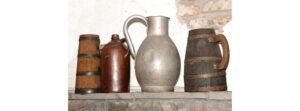Drinking Vessels in Early 1600s England

The two most commonly consumed drinks in the 1640s were ale and wine, while the most common drinking vessels were cups and goblets.
The term ‘cup’ was a generic term usually used when drinking ale. It took a variety of forms, as described below.
In addition, if men were spending an evening in a tavern or some other social event, where they may have had too much to drink, they would often be described as being ‘in their cups’. I think this is just a more polite phrase for being drunk and/or rowdy!
Drinking Vessels for Ale
1) Wooden Tankards
Within working class establishments and homes, wooden tankards were probably the most commonly used drinking vessels. In the image below, you can see that they are similar in appearance to what we in England call tankards or jugs (in northern England at any rate!) In the 17th century, some were also made with lids to keep out insects or dirt.
As well as being relatively cheap to have at home, they would no doubt be more resilient for use in inns and taverns, and less likely to be broken than other materials.
2) Leather Jacks
Sometimes known as Blackjacks, these were a step up from wooden tankards. As the name suggests they were made of leather but were lined with pitch or resin to make them waterproof. They too would be in the shape of a tankard and would be hard wearing when used in inns and taverns.
3) Stoneware / Ceramic Mugs
Sometimes called Bartmann jugs, these items probably resemble what we would today call Toby jugs. They were often decorated with bearded faces and would be more expensive as they were often imported at the time. They would obviously be more prone to breaking if they were dropped.
4) Pewter Mugs
These were used by more wealthy individuals and were more likely to be seen in houses rather than inns where, I imagine, they may fall foul of those with light fingers! A benefit of them, though, for establishments with the money and a more ‘refined clientele’ was that they were easier to clean than either the wooden or leather vessels.
Both men and women would drink from these cups, but the ladies would often have smaller versions. In my head, I’m thinking this is equivalent to a pint to for men and a half pint for women, something that is still a thing among the older generation in the UK!

Drinking Vessels for Wine
Almost by definition, those who drunk wine were part of the wealthy merchant class or the aristocracy and their drinking vessels reflected that.
1) Pewter Goblets
As shown in the image at the top of the page. These were most likely the everyday drinking vessel of choice for people who drank wine. They would also likely have been used in the taverns where wine was served. The sorts of inns where wooden tankards were used would be unlikely to sell wine.
2) Glass Goblets
Serving wine in the lead crystal was a typical way to display one’s wealth. Glass manufacturing was still in its infancy in England and glasses would most commonly be imported from the continent, particularly Venetian-style glass. These goblets would be very elegant on the table at dinner parties (feasts, banquets or junkets as they were called at the time) and showed the quality of the wine to the guests.
3) Ceramic Cups
These may have been used in more middle-class families.
Serving Vessels – Flasks and Jugs
As already mentioned, glass was not a common commodity at the time of the series and so glass bottles for ale or wine were unheard of.
Instead, they would be stored in wooden casks and when required, would be decanted into some sort of flask or jug as in the images above. Jugs would most commonly be used for ale and may be made of wood or pewter.
Wine, being mostly drunk by the wealthy, would generally be served in pewter flasks, as shown in the image at the top. Again, for those who wanted to flaunt their wealth, glass decanters may have been used.
Final Note – Cutlery
While this doesn’t warrant a newsletter of its own, it’s worth noting that in 1640s England, people, even the wealthy, would typically eat with their fingers. Spoons were used for soft foods such as soup or pottage (a type of stew), but each person would also have a sharp carving knife (often their own that they would carry with them) to cut up their food before using their fingers to pick things up. At the time, forks had been introduced into continental Europe, particularly France and Italy, but the English found this to be foreign or effeminate and resisted until the late 1600/early 1700s.
*
Additional Posts









